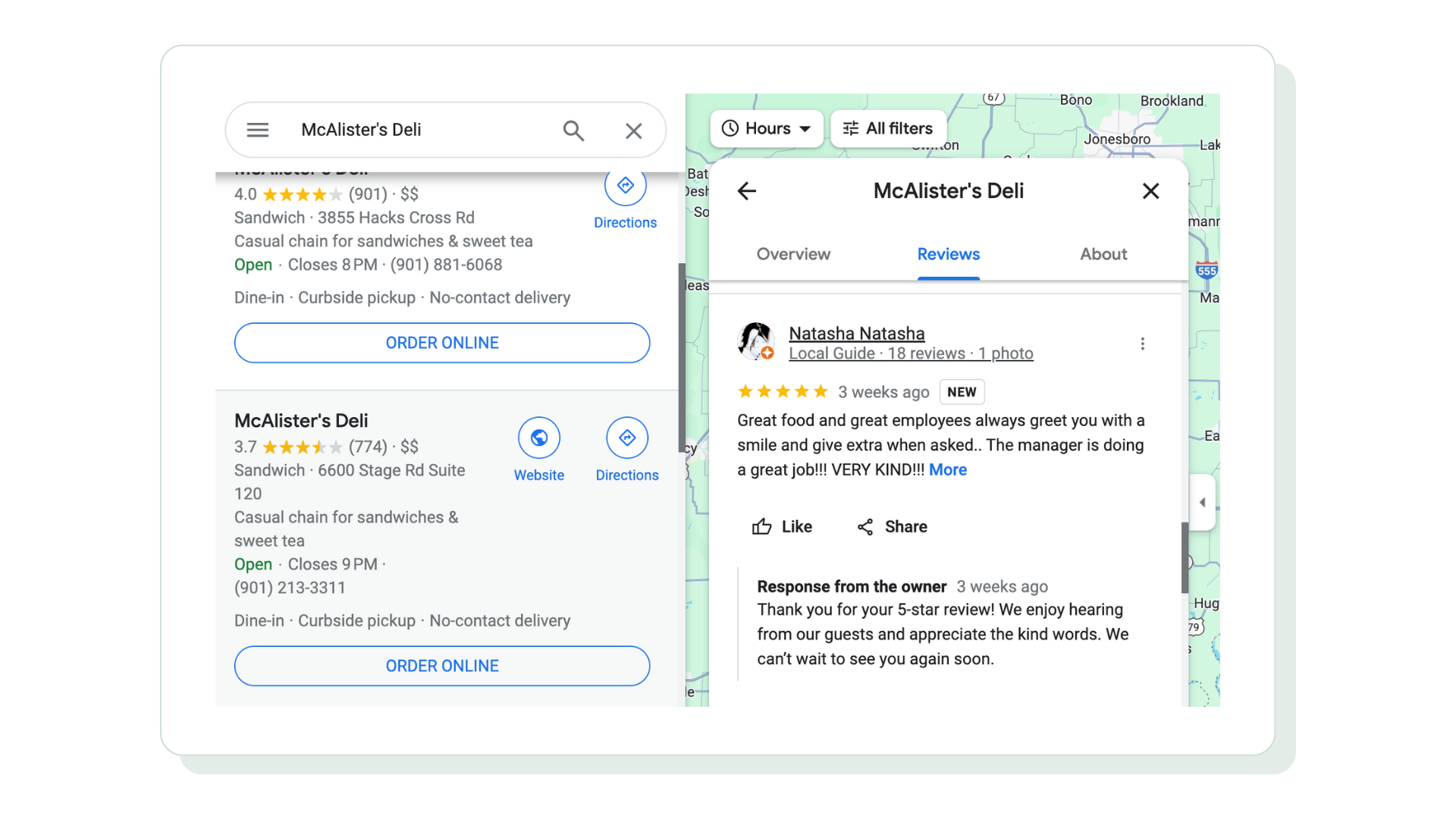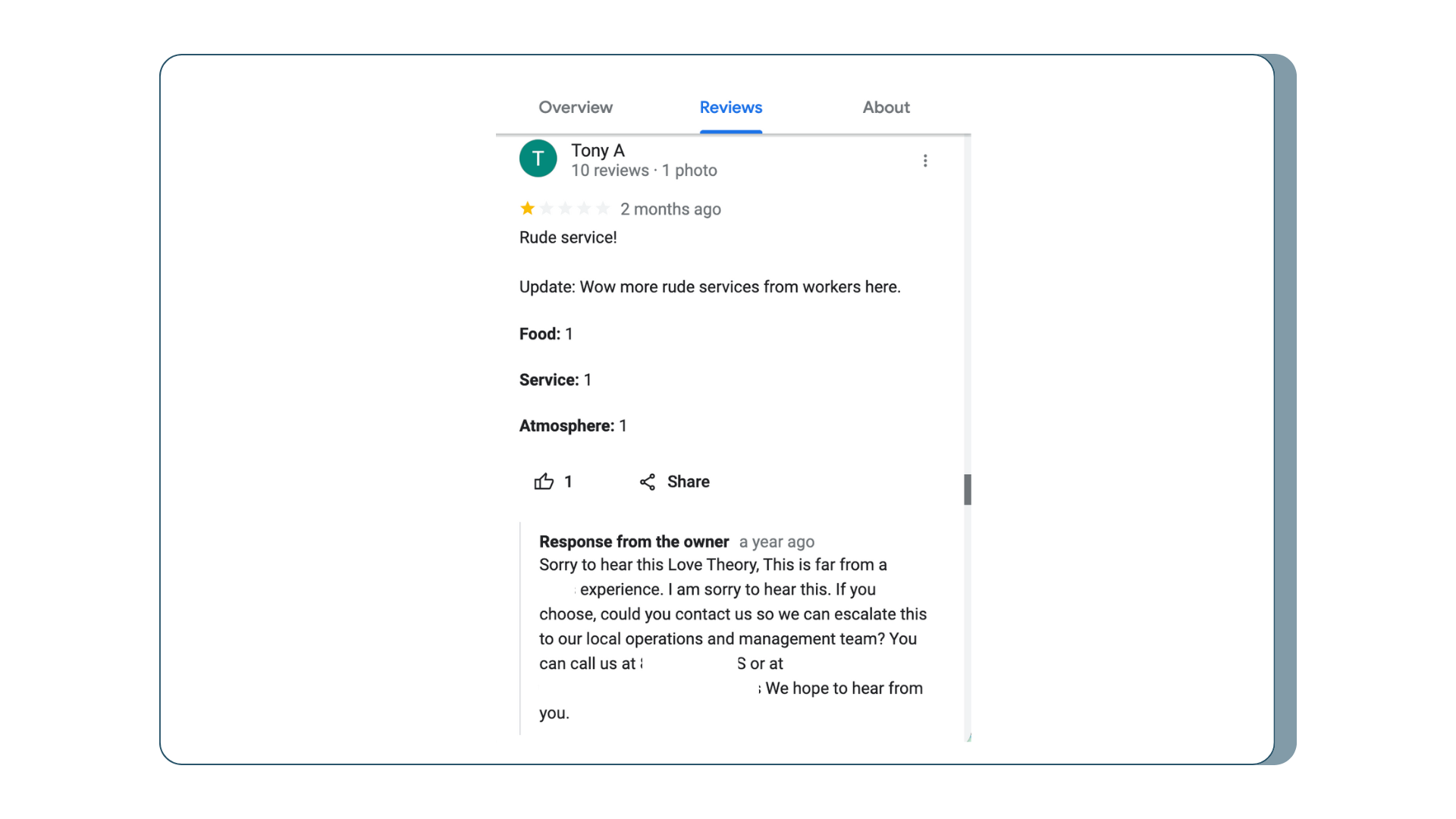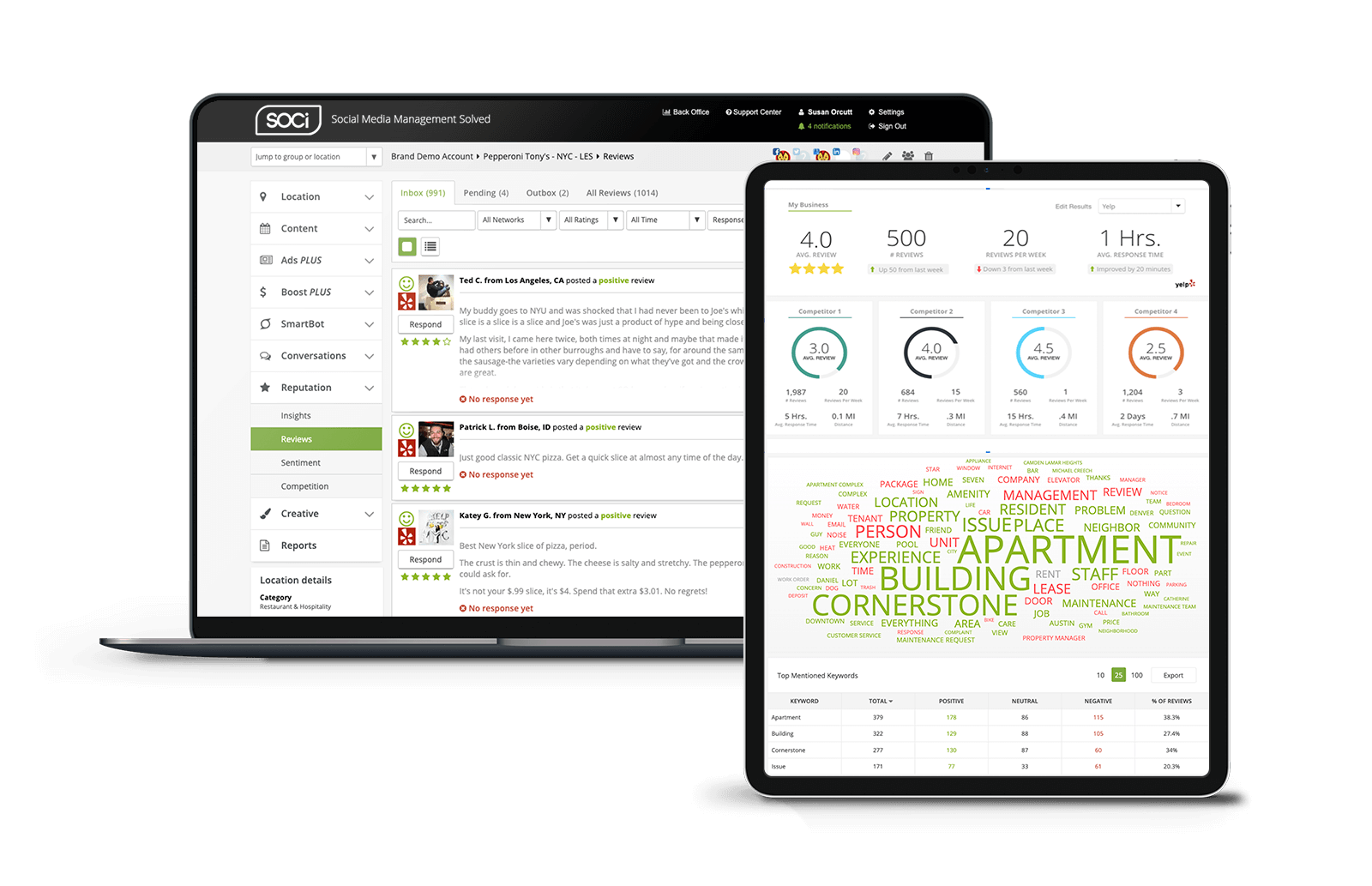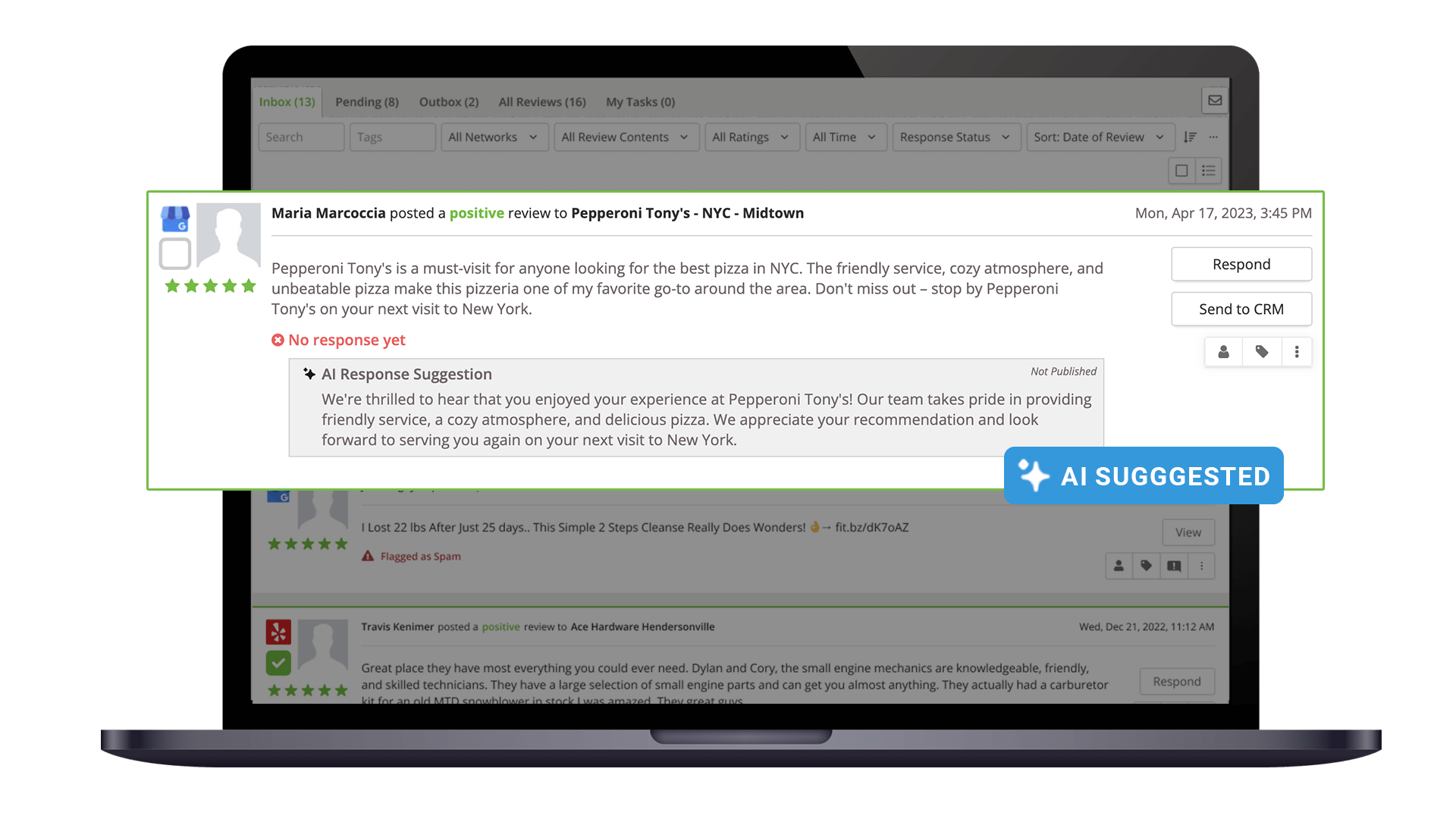More Borrowers, Less Effort: How Online Reputation & Local Search Drive Mortgage Growth
Your Comprehensive Guide to Review Management
Today, reviews matter immensely to consumers. For many, they’re one of the most influential factors when considering a purchase, which is why your business needs a review management strategy. Don’t believe us? The data speaks for itself.
- Ninety-eight percent of consumers feel that reviews are an essential resource when making a purchase decision.
- At the local level, 87% of consumers regularly read online reviews before making a purchase decision.
- More than 4 in 10 people are more likely to choose a business that responds to its online reviews.
But what is review management, and why does it matter? Let’s explore.
In this blog, we’ll define review management, explain its benefits, and detail seven tactics your business can use to manage reviews successfully. These tactics will help set your brand apart from competitors.
What is Review Management?
Review management is the process of monitoring and analyzing the sentiment of customer reviews posted on your website, local directories, and social media profiles. It also includes responding to reviews and tracking sentiment over time.
Review management is an important part of reputation management, which ensures positive sentiment around your brand by helping to control what’s being said about it.
Why is Online Review Management Important?
Review management directly influences consumer trust and decision-making, thereby impacting your business’s reputation, online presence, and bottom line.
Here are some other key benefits of an effective review management strategy:
- Enhances brand credibility and trust among potential customers by showcasing responsiveness and customer care.
- Improves search engine rankings as consistent, positive reviews signal to search engines, like Google, that your business is reputable and has high customer satisfaction.
- Increases conversion rates by providing social proof to potential customers, encouraging them to choose your services or products.
- Enables you to identify areas for improvement based on customer feedback, leading to improved product or service quality.
- Strengthens customer relationships by engaging with reviewers, showing appreciation for positive feedback, and addressing any negative experiences.
Seven Essential Review Management Tactics
Now that you understand review management and why it’s important, let’s examine seven ways to effectively manage your business’s online reviews.
1. Determine Where Customers Are Leaving Reviews
Before you can start managing your reviews, it’s essential to understand where your business receives them. Typically, you’ll find reviews on your website, local listings, and social platforms — such as Google Business Profiles (GBPs), Yelp Listings, Apple Business Showcases, Facebook, X (formerly known as Twitter), etc.
Below is an example of a review left on Google.

Once you have a list of all the places customers can and are leaving reviews, you must ensure those channels are updated with your latest business information.
For instance, do your local GBPs have the most recent and accurate business information? What about your social channels?
Maintaining up-to-date and accurate local business profiles across all platforms and on your business’s website is crucial for delivering a positive customer experience (CX). This practice also helps ensure that customers receive reliable information, enhancing their interaction with your brand.
2. Monitor Reviews Across Platforms
After determining where your business is receiving reviews, you can begin to monitor them. For multi-location businesses, you must monitor reviews across each location on every major platform.
Finding review management software that can help you monitor and track reviews is critical. We’ll discuss this further later in this blog!
While monitoring reviews is important, your business shouldn’t stop there. A comprehensive review management strategy includes responding to reviews, considering feedback, and beyond!
3. Develop a Review Response Strategy
Responding to reviews is non-negotiable. Our previous research found that:
- 4 in 10 consumers expect a reply within 24 hours of posting a negative review.
- Forty-one percent of consumers are more likely to choose a business that responds to its online reviews.
When responding to reviews, your business should prioritize the negative reviews first, followed by responding to positive reviews. You should also respond to reviews in reverse chronological order — prioritizing the most recent reviews.
Responding to reviews shows customers that you’re taking the time out of your busy day to acknowledge their feedback. This will help reinforce a positive CX to loyal customers while simultaneously attracting new ones.
Responses to reviews should be prompt and tailored, directly engaging with the specifics of the customer’s feedback.
Download our Multi-Location Marketer’s Guide to Online Reputation Management for additional tips on responding to reviews and managing your online reputation.
4. Take Negative Conversations Offline
As mentioned previously, your business should prioritize negative reviews first. When responding to a negative review, you should acknowledge the customer’s negative experience at face value while explaining what your business will do to prevent this from happening again, if possible.
Promises are meant to be kept! If you declare a change, follow through. That specific customer or others might swing by to see if you’ve made updates and kept your word.
If the conversation continues in a negative direction, take it offline. As seen in the example below, you can provide the customer with an email address or phone number they can use to get additional support.

Similarly, if you offer a customer a refund or coupon for a future visit, do that offline as well. You don’t want other customers to think they’ll receive something in return if they leave a negative review.
Encountering negative reviews is an inevitable aspect of conducting business in today’s digital landscape. The important part is how your business responds to them.
5. Encourage More Customer Reviews
After successfully creating a process for monitoring and responding to reviews, you can start thinking about ways to generate more reviews.
Our State of Google Reviews research found that for every ten new reviews earned, Google profile conversion improves by 2.8%. If you increase your GBP star rating by one full star, conversions jump by 44%. Conversions are defined as a phone call, a website click, or a request for directions.
Maintaining a steady influx of reviews should be a priority for every business and an integral part of your marketing strategy. Your brand can gain more reviews by:
- Adding a call-to-action (CTA) on both paper and digital receipts for customers to evaluate their experience.
- Utilizing social media to encourage feedback from loyal customers.
- Engaging with current reviews to show customers you value their feedback.
- Making it easily accessible to leave reviews through links on your website, social channels, and elsewhere.
- Leveraging surveys and chatbots as a tool for review collection.
While many review platforms have solicitation guidelines, the above-mentioned tactics are acceptable ways to gather more reviews. Our blog on review solicitation provides more detail.
6. Analyze Review Sentiment
While monitoring reviews and your overall star rating will give you some insight into how customers generally feel about your business, it’s crucial to analyze specific sentiments.
To do so, your business can leverage a reputation management platform that provides sentiment analysis capabilities. This sentiment analysis software will allow you to identify and manage emerging sentiments from online reviews while analyzing shifts in local reputation over time.

By analyzing online reviews’ sentiment, businesses can pinpoint exactly what customers love or dislike about their products, services, and overall CX enabling targeted improvements that directly address customer needs and preferences.
A regularly scheduled analysis, whether weekly, monthly, or quarterly, acts as an early warning system to catch and rectify issues before they escalate into negative reviews. It also ensures a continuous feedback and enhancement loop based on your customers’ opinions.
7. Make Optimizations Based on Feedback
Finally, the last step in managing reviews is making improvements based on the feedback you’ve received. Analyzing your sentiment should make this easy!
For instance, did you receive numerous mentions about the wait time at your restaurant? Are you a property management company that saw “maintenance” mentioned multiple times in your reviews?
Understanding what pain points customers are having at your business is vital. However, it’s useless unless you take the time to address and solve those pain points. That’s not to say that every negative review calls for a complete change, but if certain themes continue to appear in reviews, they’re worth addressing.
As mentioned a few times throughout this blog, improving your CX is critical, and making improvements based on what you’ve seen in your reviews will help do so.
Improve Your Review Management Strategy Today
Now that you understand what it takes to manage reviews effectively, it’s time to implement a review management solution. For multi-location businesses, managing reviews across multiple platforms and 100s or 1,000s of business locations can seem daunting — that’s where SOCi comes in!
We’ve upgraded our reputation management software with SOCi Genius, an AI automation layer, that allows local and corporate customer service teams to manage and respond to all reviews in an authentic and on-brand manner.

Genius Reviews integrates with major review sites like Google, Facebook, and Yelp. Genius Reviews isn’t just a review management tool; it can also:
- Track sentiment
- Identify emerging trends
- Monitor shifts over time
- Analyze local competitors
These capabilities help streamline the review management process, provide deeper reputation insights, and increase customer satisfaction. Clients using Genius Reviews have seen a dramatic improvement.
For instance, in one year, Ascent Hospitality Management saw a 50.3% increase in positive reviews and a 450% increase in response rates. Similarly, Kumon Learning Centers resolved 95% of reviews in Q4, 2023 across 2,000 locations with a response time of one day and 10 hours.
Request a demo today for additional insight into how SOCi can help you manage reviews with just a few clicks, and also help with your overall local marketing strategy!






